Introduction :
Marking attendance in the class meeting session of the students are the prime tasks of the subject handlers, since marking the attendance can regulate the students to attend the classes. Moreover, it verifies number of students present in the conducted classes. The purpose taking attendance is to analyse the record of the students through out the academic year. Earlier, the tasks of marking attendance are handled manually by pen and paper method. This method consumes more time and adds more workload to the subject handlers and sometimes the data may prone to error. To avoid these problems, this paper presents a mobile application for student attendance system.
Database management is one of the most basic and important system. The application based data base system, management of records and its storing process are crucial tasks which are complex but very accurate. Taking into consideration the disadvantages of traditional database system, a newly designed method of wireless application based data base system has been proposed which depends on WIFI system. In every school, college and many offices the attendance is very important means of finding the person’s regularity.
In current scenario, marking attendance in the class session of the students are the essential tasks of the subject handlers, since marking the attendance can regulate the students to attend the sessions and verify the number of students in the class. Record of attendance is inevitable to analyse the percentage record of the students in their exams. The management and maintenance of student information is a key task for any institution.
This system is active only when the internet is on since the data are not been updated with the local database. These limitations of the traditional systems are overcome by the mobile applications. The mobile application allows the users to install this application in their mobile devices. The user can update the student attendance details in the local mobile database by connecting their mobile devices with the server which keep the attendance details through internet. Hence, the updated attendance details can be viewed even offline. In orderto reduce the manual work and to achieve more efficiency in managing the student information, this paper presents a application-based mobile application to manage the student attendance and makes more easily and effectively.
ANDROID APPLICATION : Android is a software platform and operating system for mobile devices, based on the Linux kernel, and developed by Google and later the Open Handset Alliance. It allows developers to write managed code in the Java language, controlling the device via Google-developed Java libraries. There are over 300 million Androids in use and over 850,000 devices activated every day. Android is the one of the most used mobile operating system with a market share of 48% and Over 400,000 applications available in Google play store. Figure 1.2.1 shows the android application for taking the attendance. The name of application is Mobile Attendance System.
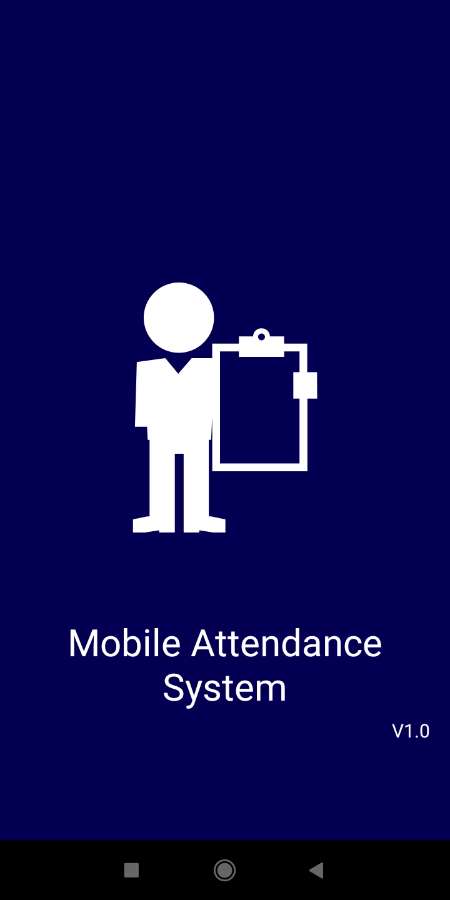
EXCEL SHEET : Need to keep an attendance record for your meetings,school or class. This free attendance record template is very easy to use. Mobile application will create a separate record for each class by making a copy of the worksheet. Enter the names of the students then it will save a copy to put in your attendance record. Use this attendance sheet on your phone or other mobile device to keep track of attendance in your classes or meetings. If you don't have it already, you will just need to install the Excel app. Save the file to One Drive to sync your changes with your other devices, or download the file directly to your phone.
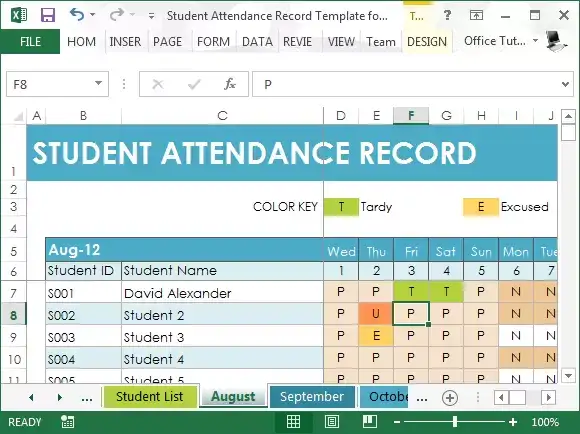
CLOUD : Cloud storage is a cloud computing model in which data is stored on remote servers accessed from the internet, or cloud. It is maintained, operated and managed by a cloud storage service provider on a storage servers that are built on virtualization techniques. Cloud Storage is a service where data is remotely maintained, managed, and backed up. The service is available to users over a network, which is usually the internet. It allows the user to store files online so that the user can access them from any location via the internet.
PROJECT IMPLEMENTATION :
BLOCK DIAGRAM : The system consists of Power Supply, Android Application, Raspberry PI module, Excel Sheet .
.png)
- POWER SUPPLY : Model uses 05 volts power supply and it has ability to drive 2.5 amperes of current.
- ANDROID APPLICATION : Android is a software platform and operating system for mobile devices, based on the Linux kernel, and developed by Google and later the Open Handset Alliance.
- RASPBERRY PI MODULE : The Raspberry Pi is a series of small single-board computers developed in the United Kingdom by the Raspberry Pi Foundation to promote teaching of basic computer science in schools and in developing countries.
- EXCEL SHEET OF ATTENDANCE RECORD : This attendance sheet on your phone or other mobile device to keep track of attendance in your classes or meetings.
WORKING PRINCIPAL :
INPUTS AND OUTPUTS : The input is android application.The output is excel sheet filled with the attendance data.
ANDROID APPLICATION : The mobile attendance system has been built to eliminate the time and effort wasted in taking attendances in schools and colleges. It also greatly reduces the amount of paper resources needed in attendance data management. This is an android mobile app. It’s built to be used for school/college and industries or any of the organizations so that they may take students or employees attendance by their phones.
RASPBERRY PI :
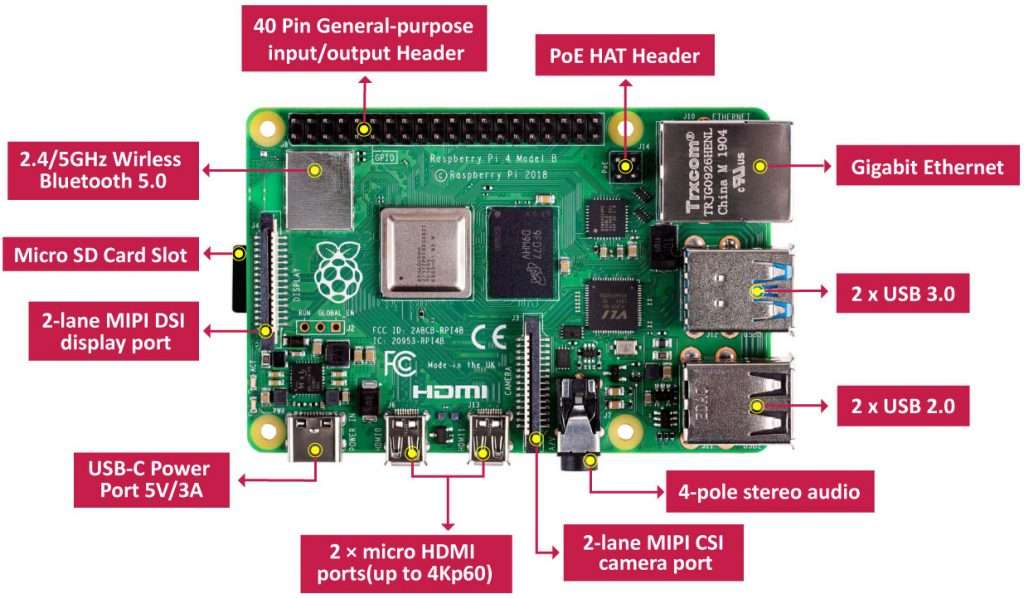
As the fig shows the various components on the Raspberry Pi board and the working of these componants are shown below :
- ARM CPU/GPU - This is a Broadcom BCM2835 System on a Chip (SoC) that's made up of an ARM central processing unit (CPU) and a Videocore 4 graphics processing unit (GPU). The CPU handles all the computations that make a computer work taking input, doing calculations and producing output, and the GPU handles graphics output.
- GPIO - These are exposed general-purpose input/output connection points that will allow the real hardware hobbyists the opportunity to tinker.
- RCA - An RCA jack allows connection of analog TVs and other similar output devices.
- Audio out - This is a standard 3.55-millimeter jack for connection of audio output devices such as headphones or speakers. There is no audio in.
- LEDs - Light emitting diodes, for all of your indicator light needs.
- USB - This is a common connection port for peripheral devices of all types including your mouse and keyboard. Model A has one, and Model B has two.
- HDMI - This connector allows you to hook up a high definition television or other compatible device using an HDMI cable.
- Power - This is a 5v Micro USB power connector into which you can plug your compatible power supply.
- SD cardslot - This is a full sized SD card slot. An SD card with an operating system (OS) installed is required for booting the device. They are available for purchase from the manufacturers, but you can also download an OS and save it to the card yourself if you have a Linux machine and the wherewithal.
- Ethernet - This connector allows for wired network access and is only available on the Model B.
Many of the features that are missing, such as WiFi and audio in, can be added using the USB port or a USB hub as needed.
Implementation :
.png)
Above fig shows the implementation of the project, the hardware we required in the project that is raspberry pi module, 5 volt adapter, connecting wires, desktop screen etc.
We have done the implemention of sample LED ON-OFF program with the help of raspberry pi module, for doing all the process of the project or a program we required internet connection which can be connect with raspberry pi module and the process of the implementation is as follow :
- Connect the power supply to the raspberry pi module.
- Connect the screen to raspberry pi module.
- Configure the raspberry pi using pibakery software.
- Set the id and password in the raspberry pi which we have to connect with wifi network.
- Connect raspberry pi module to the wifi or internet network.
- Enter user name and password which have registered while configuring the pibakery software.
- Open a program which is stored in the sd card of the storage of raspberry pi module.
- The run the program and connect the LED to GPIO pins of the module.
- While running the program LED will get turn ON and OFF as blinking state.
- This is the implementation of sample LED ON OFF program using the setup of project.
HARDWARE AND SOFTWARE :
HARDWARE DESCRIPTION : To implement such a project, the main and most important step was finding the hardware to use for the device. We have chosen a Raspberry Pi model to use in our device. We have done a lot of research, and compared elements in different microcontrollers, like, cost, processing, and user friendliness. The main reasons why we have chosen this specific element are the high processing capacity, relatively low price, and its ability to adapt in different programming modes. The device uses python and Rasbian as an operating system, which has access to a large number of libraries and applications compatible with it.
External power supplies are used both with equipment with no other source of power and with battery-powered equipment, where the supply, when plugged in, can sometimes charge the battery in addition to powering the equipment.
As well as to implement the project or taking the attendance a smartphone is required when installing a attendance taking apk software. Smartphones are a class of mobile phones and of multi-purpose mobile computing devices. They are distinguished from feature phones by their stronger hardware capabilities and extensive mobile operating systems, which facilitate wider software.
SOFTWARE DESCRIPTION : Python is an interpreted, high-level, general-purpose programming language,Python is dynamically typed and garbage-collected. It supports multiple programming paradigms, including procedural, object-oriented, and functional programming.Python features a dynamic type system and automatic memory management. It supports multiple programming paradigms,including object oriented, imperative, functional and procedural, and has a large and comprehensive standard library.
Python interpreters are available for many operating systems. C Python, the reference implementation of Python, is open source software and has a community-based development model, as do nearly all of Python's other implementations. Python and C Python are managed by the non-profit Python Software Foundation.
Python's statements include :
- The if statement, which conditionally executes a block of code, along with else and elif (a contraction of else-if).
- The for statement, which iterates over an iterable object, capturing each element to a local variable for use by the attached block.
- The while statement, which executes a block of code as long as its condition is true.
- The class statement, which executes a block of code and attaches its local namespace to a class, for use in object-oriented programming.
- The def statement, which defines a function or method.
- The break statement, exits from the loop.
- The assert statement, used during debugging to check for conditions that ought to apply.
RESULTS :
So as per our project name is Application based Attendance system by Raspberry pi module. We have used one application for marking of the attendance.The name of the application is Mobile Attendance System. So in this we are going to see the results of the attendance system.
The system is divided into following modules :
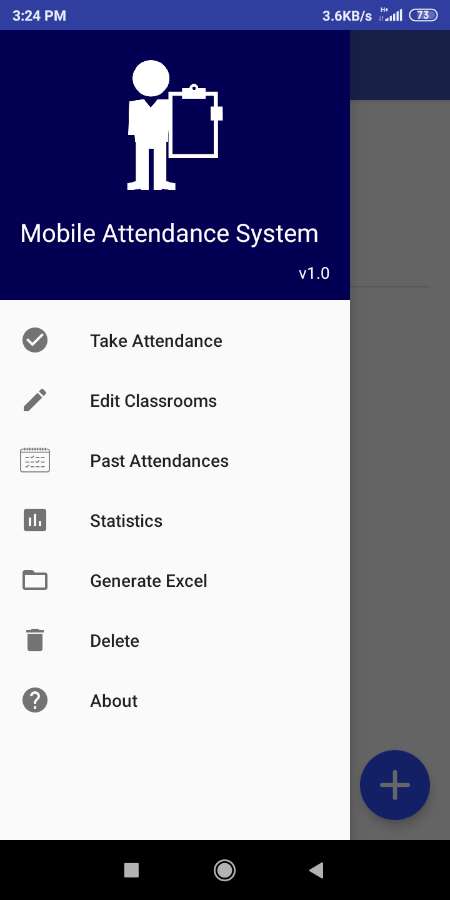
So we can see in this image that there are six tables are given namely as :
1) Take Attendance
2) Edit Classroom
3) Past Attendance
4) Statistics
5) Generate Excel
6) Delete
We can see that these are the tasks or information we can take from this application.
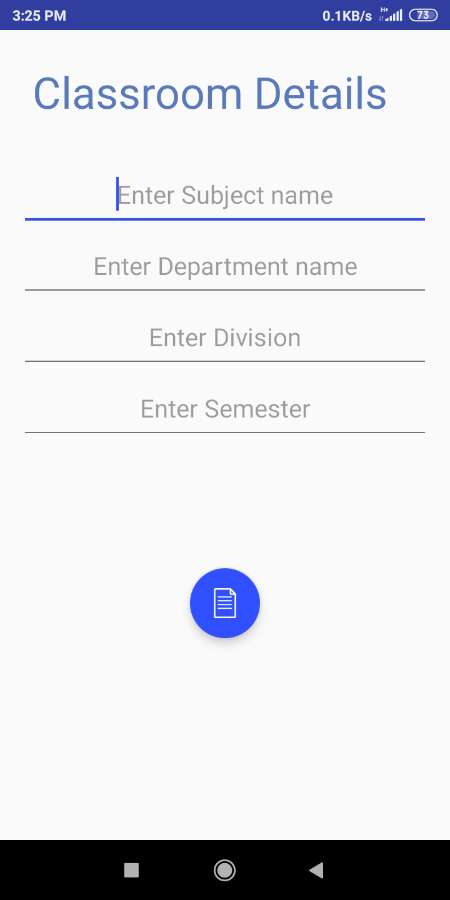
So this is the section of the classroom details in which we have to fill the information of our respective classroom. There are four lines they have given in which we have to fill our respective subject name, our department name, division and semester.
It can only access by the respective sir or madam to marking attendance. As the subject get changes the staff also gets change so as per their respective subjects to their respective staffs this section is going to work and mark the attendance.
As we can see their one symbol of page in blue circle that indicates the generation of the classroom through which staff can enter to mark the attendance.As when we press on that classroom name then there comes the option of the making of students list which are in that particular classroom. As we know, this section contains information about our Classroom.
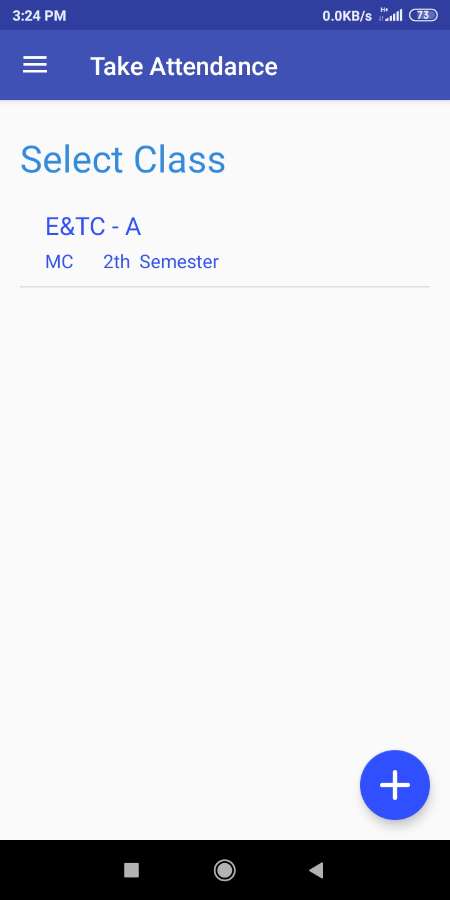
As shown in above figure after the generation of the classroom we can see the classroom name under the select class. We have given E&TC – A name to our classroom. When we press on the take attendance that time this page gets open of the classroom name.
There is a symbol of plus sign (+) in the blue circle. The meaning of that circle also indicates that when we press on that symbol there is one page generate and that page is also of the generation the room.
As when we press on that classroom name then there comes the option of the making of students list which are in that particular classroom. After opening our classroom we can see there names of the students which are admitted to the classroom. The students names who are present and also absent in the class that students list is shown in the respective classroom. So after creation of the list we are ready to take our next step that means to mark the attendance of the students.
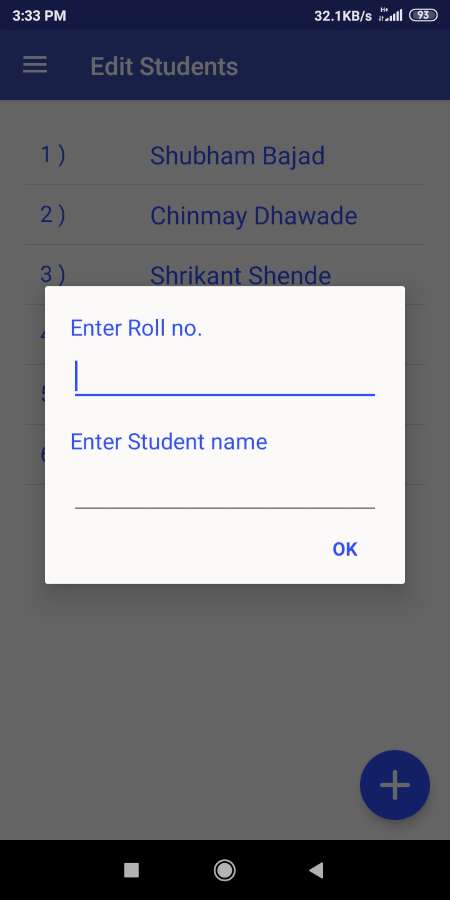
After the generation of the classroom now we have to add students in the particular classroom as department wise.So, to add the students in the classroom we have to press on that symbol which we can see at the below right side of the picture in the corner. That symbol also indicates the plus symbol. That plus symbol is nothing but the symbol of addition of students.
After pressing that symbol there opens one page in which we can see two tables the first one is for Roll number and another one is for Students name. After entering both details we have to press on that ok button and then we can see the name of students get added in the particular classroom. After addition of the students name in the classroom we have to see that there is any division or not.
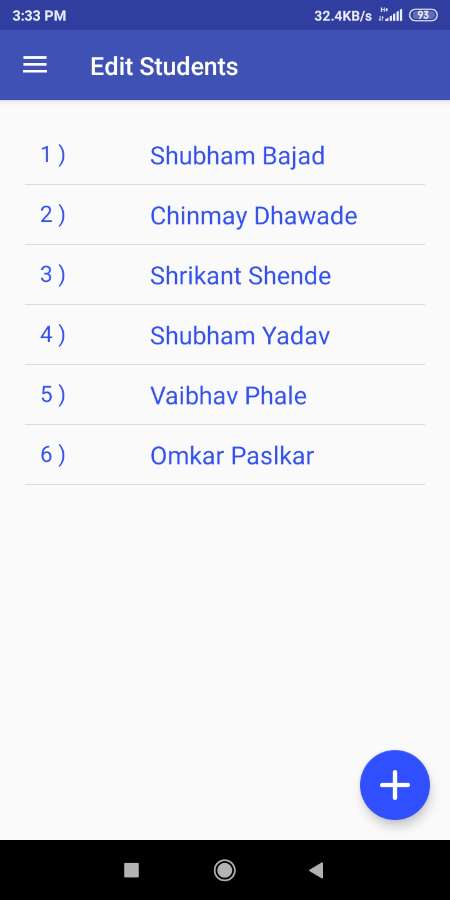
As we can see here the names of the students in their classroom. That plus symbol indicates for the addition of more students. We can add more students from their in to the classroom. After we have created the list of the students if there occurred some mistake in the name of the student so we can recover that mistake by pressing long on the name of the student. After pressing long on the name of the student there comes 2 options. First one is edit student name through which we can recover the mistake and The second option is Delete student name.
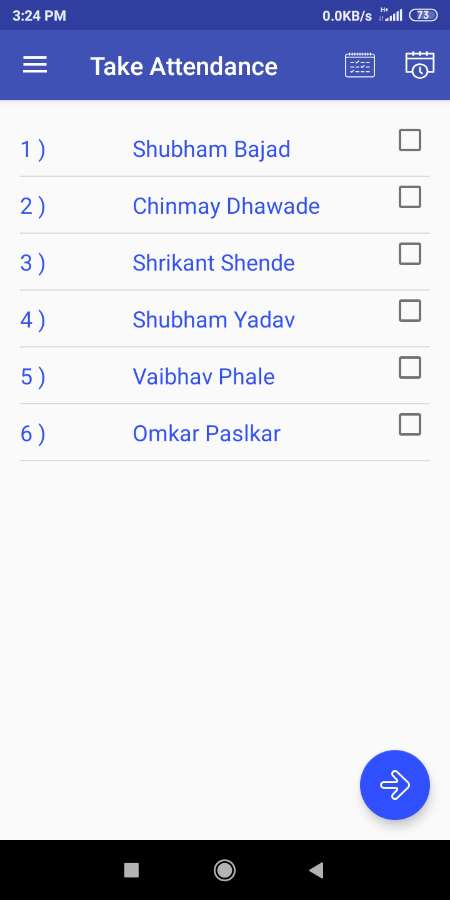
Now we have to mark the attendance, so to mark the attendance we can see their checkbox in front of every name. When we press in that checkbox that time the attendance of the student get marked by the respective teacher.
As we can see there 2 symbols in the above right corner. First symbol is for Past attendance in which we can see the past attendance of the students from which we can take average attendance of the students so we can send that attendance to their parents.Second symbol is for setting of the time and also for the setting of the calendar.
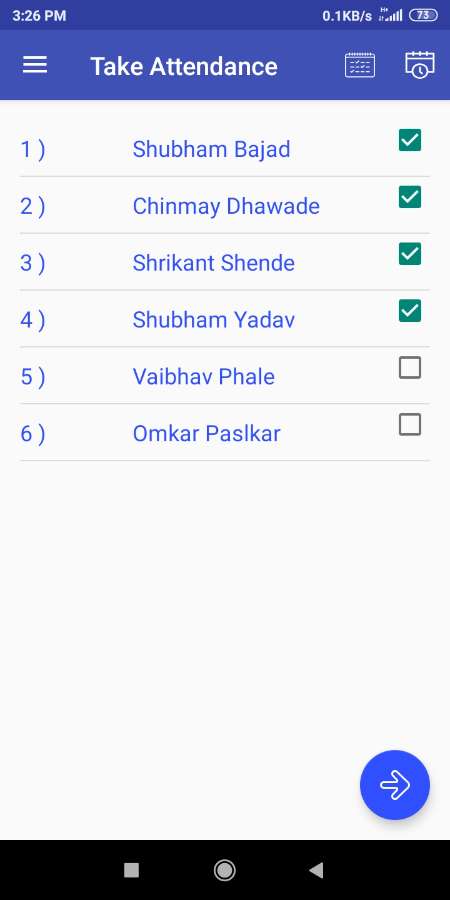
Now we can see from this image the checkbox are get filled by the right tick that means its meaning is that the attendance of the students get marked.
We can see one symbol there below at the corner which indicates arrow indication. After pressing that symbol it takes us towards the list of the present and absent students.
After taking attendance of the students we can see that arrow and after pressing that arrow key it moves towards the next page which is of the Present students list page. After completing the list of the students who are present then there we can see total number of students present.
And after this all process there is symbol of generating excel sheet of the students whose are present and also absent.
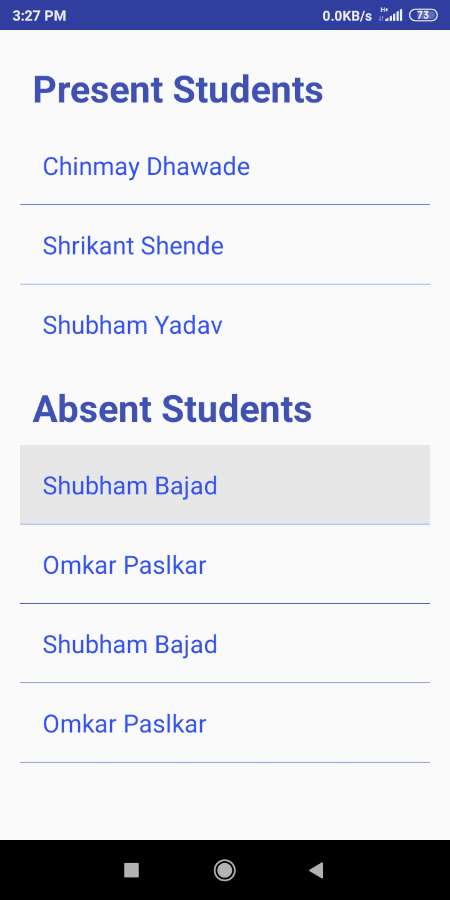
As we can see here the list of the students that who are present and who is absent. From this image we can take the sure number of students who are present and who are absent.
After the completion of whole process there is one option for making of the Excel sheet where we have to store our marking of attendance information.As the Excel sheet get created then we are ready to give that Excel sheet to the respective departments HOD or to the principal or to the parents of the students, through which they also get know that how much averagely their children attending the lectures and colleges.
Thus this system automates attendance system and eliminates the use of paperwork needed for attendance marking and monitoring student attendance.
After this whole process there is one option of Statistics. In this we can see our classroom name after open the classroom there comes the list of the total students who are admitted to the classroom. After opening the students name we can press on the particular student name after pressing the details of the particular student get opened. In which the total data for that student get opened and also we can get the dates on which student was present.
Conclusion : The part of the android application get completed. So we have also managed some of the more mobile facilities related to this application that means we can stored our this Attendance record in the mobile storage wherever we want. Also we have managed to send this Attendance record on the E-mail addressed to the respective Parents of the students. We have done this systems just because of the back-up purpose.
SUMMARY :
By this system Attendance marking and report generation becomes easy. Less chances of malfunctioning are there. The system has reached a steady state where all bugs have been eliminated. The system is operated at a high level of efficiency and all the teachers and user associated with the system understands its advantage. It was intended to solve as requirement specification.
